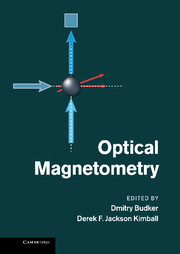Book contents
- Frontmatter
- Contents
- List of contributors
- Preface
- Part I Principles and techniques
- 1 General principles and characteristics of optical magnetometers
- 2 Quantum noise in atomic magnetometers
- 3 Quantum noise, squeezing, and entanglement in radiofrequency optical magnetometers
- 4 Mx and Mz magnetometers
- 5 Spin-exchange-relaxation-free (SERF) magnetometers
- 6 Optical magnetometry with modulated light
- 7 Microfabricated atomic magnetometers
- 8 Optical magnetometry with nitrogen-vacancy centers in diamond
- 9 Magnetometry with cold atoms
- 10 Helium magnetometers
- 11 Surface coatings for atomic magnetometry
- 12 Magnetic shielding
- Part II Applications
- Part III Broader impact
- Index
6 - Optical magnetometry with modulated light
from Part I - Principles and techniques
Published online by Cambridge University Press: 05 May 2013
- Frontmatter
- Contents
- List of contributors
- Preface
- Part I Principles and techniques
- 1 General principles and characteristics of optical magnetometers
- 2 Quantum noise in atomic magnetometers
- 3 Quantum noise, squeezing, and entanglement in radiofrequency optical magnetometers
- 4 Mx and Mz magnetometers
- 5 Spin-exchange-relaxation-free (SERF) magnetometers
- 6 Optical magnetometry with modulated light
- 7 Microfabricated atomic magnetometers
- 8 Optical magnetometry with nitrogen-vacancy centers in diamond
- 9 Magnetometry with cold atoms
- 10 Helium magnetometers
- 11 Surface coatings for atomic magnetometry
- 12 Magnetic shielding
- Part II Applications
- Part III Broader impact
- Index
Summary
Introduction
Soon after the development of optical magnetometers based on the radio-optical double resonance method (see Chapter 4), it was realized by Bell and Bloom [1] that an alternative method for optical magnetometry was to modulate the light used for optical pumping at a frequency resonant with the Larmor precession of atomic spins. In a Bell-Bloom optical magnetometer, circularly polarized light resonant with an atomic transition propagates through an atomic vapor along a direction transverse to a magnetic field B. Atomic spins immersed in B precess at the Larmor frequency ΩL, and when the light intensity is modulated at Ωm = ΩL, a resonance in the transmitted light intensity is observed. The essential ideas of the Bell–Bloom optical magnetometer are reviewed in Chapter 1 (Section 1.2), and can be summarized in terms of what Bell and Bloom termed optically driven spin precession: in analogy with a driven harmonic oscillator, in a magnetic field B atomic spins precess at a natural frequency equal to ΩL and the light acts as a driving force oscillating at the modulation frequency Ωm. From another point of view, the Bell-Bloom optical magnetometer can be described in terms of synchronous optical pumping: when Ωm = ΩL, there is a “stroboscopic” resonance in which atoms are optically pumped into a spin state stationary in the frame rotating with ΩL. Depending on the details of the atomic structure, the spin state stationary in the rotating frame can be either a dark state that does not interact with the modulated light or a bright state for which the strength of the light–atom interaction is increased.
- Type
- Chapter
- Information
- Optical Magnetometry , pp. 104 - 124Publisher: Cambridge University PressPrint publication year: 2013
- 2
- Cited by



